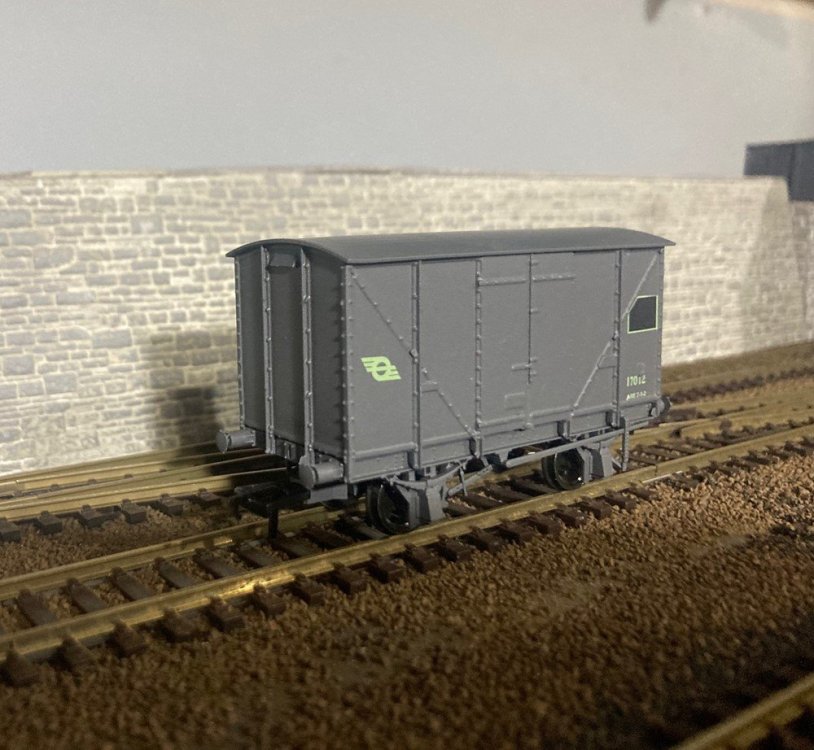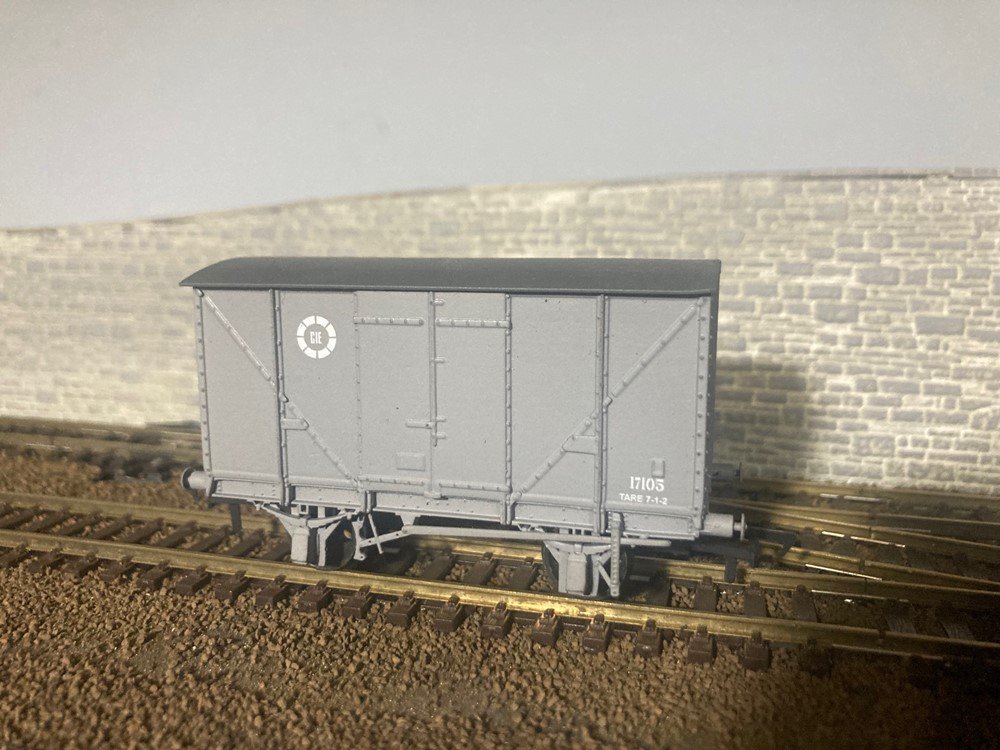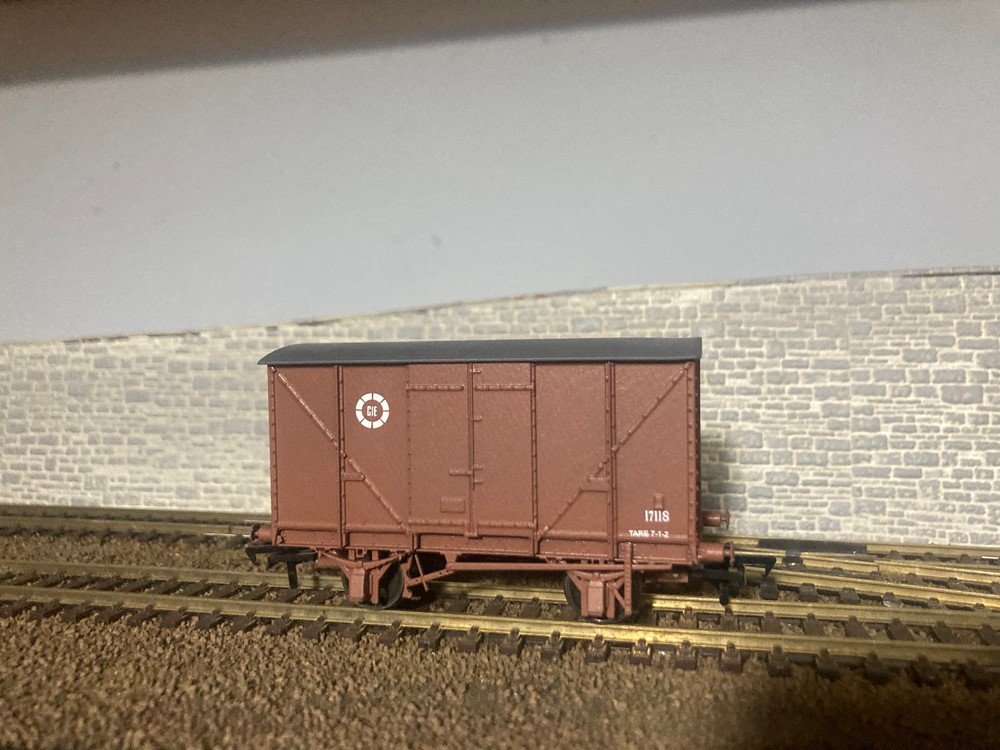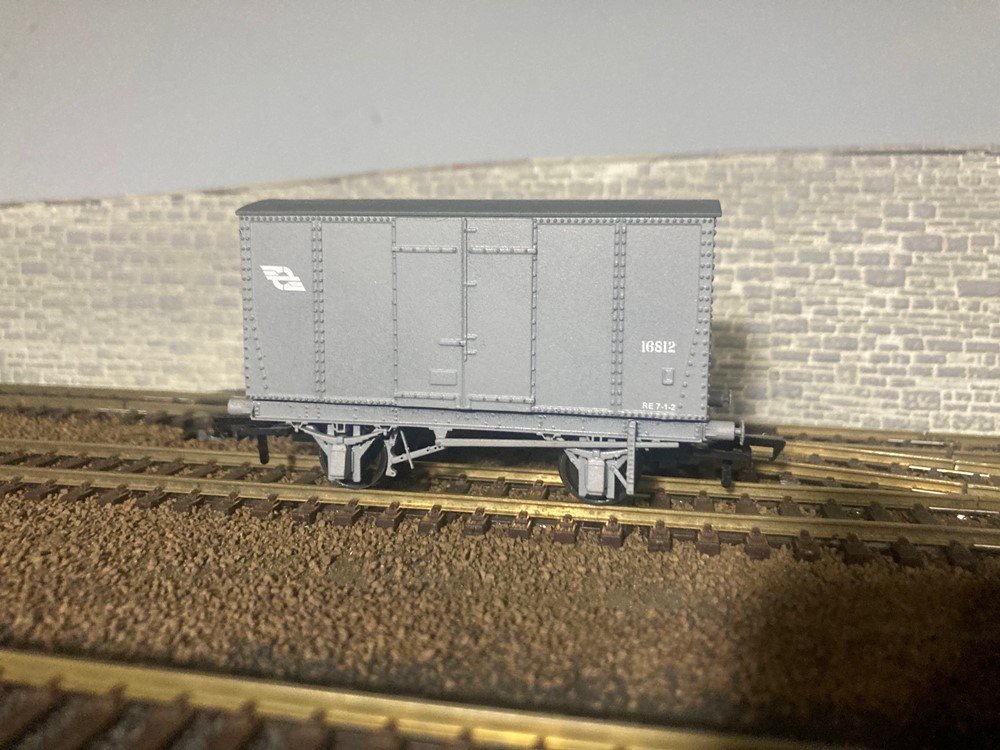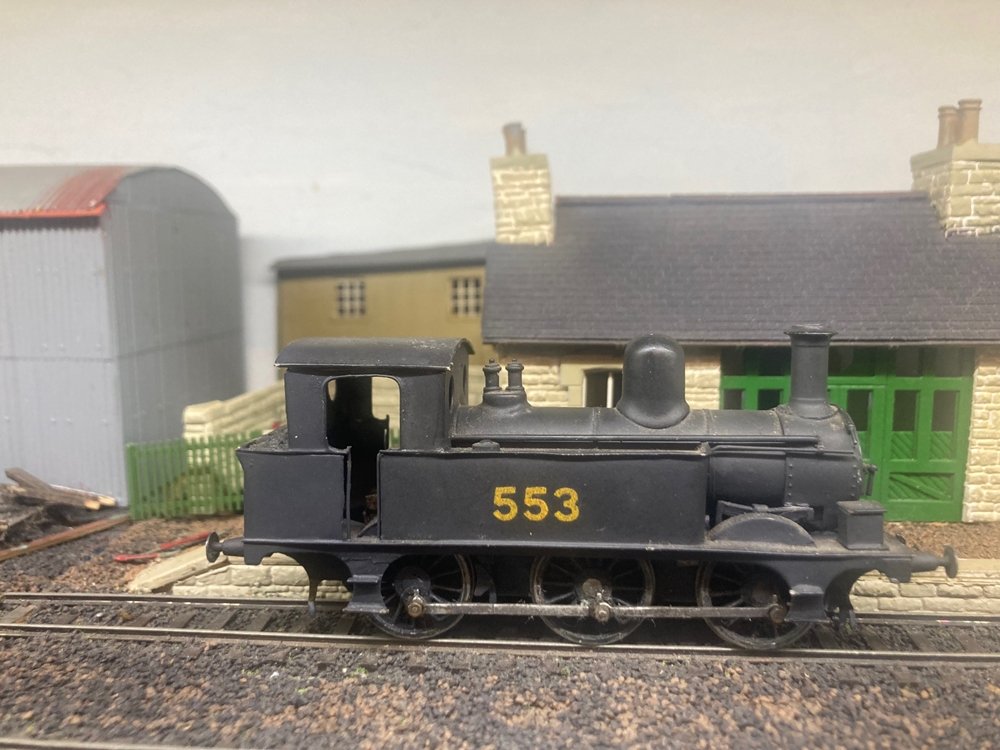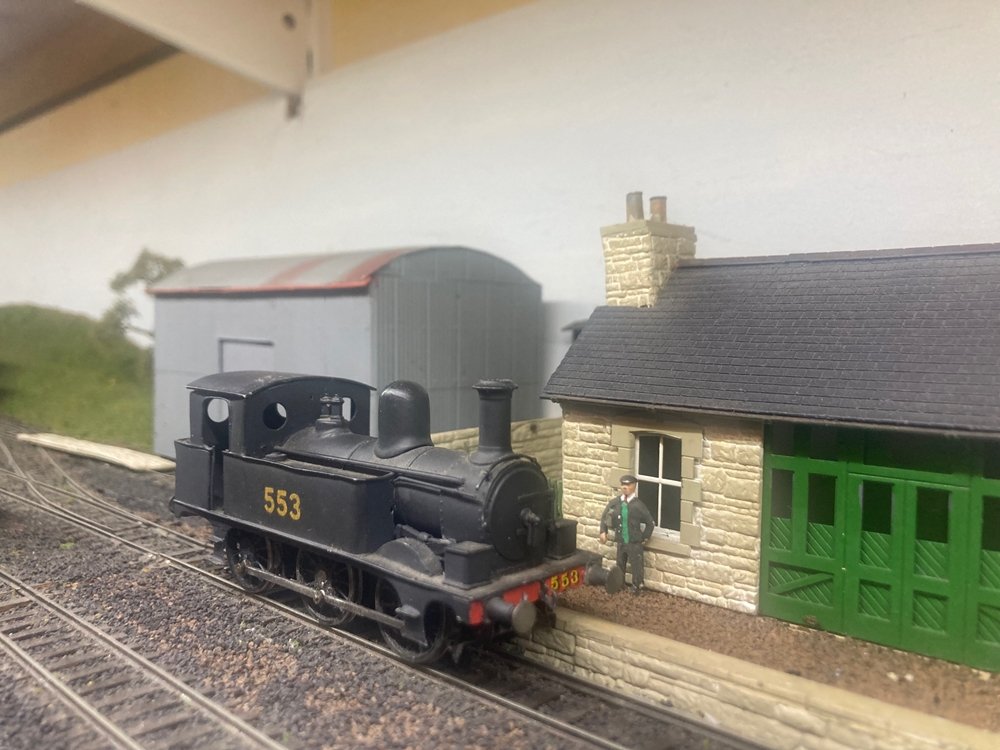-
Posts
4,878 -
Joined
-
Last visited
-
Days Won
119
Content Type
Profiles
Forums
Events
Gallery
Everything posted by Mayner
-
Look's great, I explored the Cavan Branch between Inny Junction and Crossdonney Junction on a Summer Holiday day trip from Dublin in 1985, at the time Ballywillian was a pretty unspoiled Midland Station the only thing missing being the track and signals. Gilligan's pub/farmhouse inspired a 4mm model but I never got round to the other buildings
-
I used to use a Canon entry level SLR usually on a tripod for model railway photos, but now use an iPhone for rolling stock photos. The SLR comes into its own when you need an increased depth of field for taking photos of complete trains or along a layout. Using a tripod I set the SLR on aperture priority (Av) mode selecting a small aperture F11>22 the camera automatically sets the exposure speed . My Irish narrow gauge layout has a lighting pelmet and self adhesive LED strip lighting which works out well. My workshop has neutral natural lighting with south facing windows (Southern Hemisphere!) and LED room lighting, but will install lighting pelmets and LED strip lighting if I ever get round/live long enough to build a layout. Keadue LED strip lighting I Phone approx 600mm depth of field. North Wharf depth of field test Canon EOS1200D Av setting on Tripod room lighting. most of train if focus iPhone photo E421 same lighting wagons in background out of focus.
-
The Brake Van was basically to test demand and the suitability of 3D Printing for low volume manufacture. Future Brake Van production will be at a similar price point to the Bulk Grain wagons. I originally looked at commissioning the Brake Van as a rtr plastic injection model direct from a Chinese factory and while we could produce a high quality model at a competitive price, I was not convinced that I could sell enough (2-3000) models in order to cover my costs and make a profit on the venture. The Brake Vans were 3D printed in China by a company that was highly recommended and produced very good test prints, but ran into serious quality problems with the production prints, resulting in a lot of re-work and a 3-6 month delay in releasing the finished models. Our models are now printed by a locally based company that produces high quality prints in a resin with similar properties to injection molded plastic at a significantly higher cost. The downside is that most 3D print houses are reluctant to undertake low volume manufacture of small scale models and I don't particularly want to spend over $100,000 in setting up to take the printing in-house ( approx. $100K for a suitable bottom up printer, $10-20K hazardous substance and temperature and humidity controls in an existing workshop. The Jury is still out on whether there is sufficient demand to make it worthwhile to continue manufacturing 3D printed RTR and CKD wagons, a lot depends on the continued goodwill of a single print house, 2022 will test whether it is viable to continue production of existing and develop new models. While there is a lot of talk about the potential for new models on the this news group the availability of high quality rtr models from the Far East has contributed to un-realistic expectations among modellers that its viable to produce rtr models (preferably plastic injection) of most of the locos and rolling stock that ran on Irish Railways. This has symied demand for kits and components as an increasing proportion of modellers are willing to wait in the expectation that a manufacturer will produce a high quailty rtr model of a particular loco or item of rolling stock rather than attempt a kit or heaven forbid attempt a scratchbuild.
-

Sourcing scale/prototype drawings for preserved locomotives.
Mayner replied to Hadren Railway's question in Questions & Answers
Irish Railway Record Society have digitised some GNR(I) loco drawings https://irrs.ie/archives/maps_drawings/ NCC, GNR(I), BCDR drawings may be available through the Ulster Folk and Transport Museum. Manchester Museum of Technology Beyer Peacock collection includes locos supplied to Irish Companies including the DSER 2-6-0s and various SLNCR 0-6-4T New Irish Lines published GSR loco and tender diagrams including DSER Moguls https://newirishlines.org/contact/ the editor Alan O'Rourke may be able to assist -
There appears to have been approx. 320 "Fitted" H Vans with 18542-18761 built with Vacuum Brakes for running with passenger trains and 18762-18861 built in 1958 fitted with vacuum brakes in 1961/62 15 of which were fitted with sliding doors similar to the 26001 series pallet vans of 1964. The "Fitted" H Vans appear to have been restricted to a max. speed of 35mph which would have limited their usage on passenger trains, a green H van with black ends is just about visible in a John Phillips colour photo of Sambo (steam) shunting in Irish Railways in Colour a second glance Tom Ferris Midland Publishing 1975. The vacuum brake gear appears to have been isolated on most of the fitted vans in their final years, I visited Mullingar in the early 80s where a large number of H and Pallet wagons were stored waiting scrapping. The fitted H vans were all lettered (professionally) to the effect that they were hand brake only power brakes isolated, I didn't have a camera on the day but managed a pencil sketch of the sole surviving GNR Bulk Cement and a H Van.
-
Railtec Models finalised the transfers for the majority of our current and planned wagons in January and I completed some decorated samples of the Covered and Open Wagons. 17012-17211 Series covered wagon original 1946 dark grey scheme with green snail and lettering and black chalk board. 17012-17211 Series covered wagon light grey scheme with white snail logo and lettering. 17012-17211 Series covered wagon 1960s grey scheme with white wheel logo and lettering. 17012-17211 Series covered wagon 1970s brown scheme with white wheel logo and lettering. RCH/GSR Standard open wagon with snail logo. IRCH/GSR Standard open wagon with wheel logo. The wagons will also be available in undecorated form with a decal set with both white snail and wheel logos and 10 sets of running numbers. And now for something completely different. Following the theme of modelling the less common versions of the "Standard' CIE H Van a model of the rare LMA Wagons (Light Metal Alloy) built in the early 1950s before the introduction of the "Standard" H Van with plywood body and Bullied underframe. 16812 was the last of the 15147-16812 series 10T covered wagons built by the GSWR/GSR/CIE from 1915 onwards the remainder of the LMA wagons 17213-17221 were built in 1952 The buffers on the test print chassis had a bit of an accident and we have beefed up the buffer shanks on the LMA and "Standard" covered wagons which share a common (not quite) chassis. I was always fascinated by these wagons as although described in "Irish Railways Today" (Pender and Richards 1967 & Locomotives and Rolling Stock of CIE & NIR (Doyle and Hirsch) they were extremely photo shy I did not come across a physical example until I came across the grounded body of 16812 in use as a store on a construction site in 1982-3 and did not see a photo of a complete wagon until I saw a photo of a pair of LMA wagons awaiting scrapping on the IRRS Flickr site. I am currently fulfilling existing orders for the Open, Covered and Grain wagons with our first batch of 2022 models currently at the printers. I am planning to update the website during the next two weeks. Shipping: Currently items are taking 4-5 weeks to reach Ireland and Australia with shorter transit times to the United States, the UK and Continental Europe and is likely to remain un-predictable as Ormicron continues to its stuff.
- 23 replies
-
- 11
-

-

-
Tri-ang Clerestories have been successfully re-built into GSWR arc roof coaches. Tim Cramer rebuilt one into a 21mm gauge GSWR 45' arc roof coach in CIE early green livery during the early 1970s, the coach along with Tim's 21mm gauge scratchbuilt models of No90, a Midland and a Bandon Tank were featured in a Railway Modeller article during the early-mid 1970s. The 4mm models were sold through The re-build was extensive basically retaining the coach sides and discarding the remainder of the Triang/Hornby body shell, with new plasticard, floor partitions, (vertical) ends and roof to produce a scale width GSWR coach and 21mm gauge bogies. It should be simple enough to convert one of these coaches to represent the 'Shortie" coaches used on the West Cork by removing a compartment and fitting an arc roof.
-
The Pallet/Bagged Cement wagons were introduced in the mid 1970s with ribbed sided vertically opening balanced doors, the balanced doors on some but not all wagons were replaced with curtain sides during the 1990s, both variations were in service until bagged cement traffic ceased in the early 2000.
-
The Bagged Cements & Beet Doubles were mounted on 25436-25982 Steel Floor flat wagons built during the mid 1960s sometimes described as "Lancashire Flats"
-
The best answer is probably yes and no! The Flats, Oil Tank , Hopper Wagons, Bulk Cement, Byrytes and Zinc Ore Wagons all share a CIE "Standard 20' Underframe" but there were significant differences between the individual types of wagon. The Skeletal Flats and Oil Tank Wagons had different framing to the Bulk Cement and Hopper wagons, hence Garfield's and BosKony's comments about having covered all possible variants to the Hopper & Bulk Cement Wagon chassis. The 'Standard" 20' flats break down into two groups 546 steel floored flats dating from the mid 60s which were eventually re-built into Bagged Cement and Beet Double Wagons and 200 Skeletals introduced in 1970 The 'Classic" 22'6" Flats were a new design introduced in the 1970s to carry 8'6" containers completely different in design to the CIE Standard 20' Underframe.
-
It looks like the wagons piled up or telescoped following a derailment and were dumped in the siding at Kilmacthomas, possibly as a result of a hot box or a broken axle on one of the wagons. The wrecked tank wagons were at Kilmac and a crippled magnesite at Ballinacourty on the final day of operation when a Quigley staff excursion and an IRRS "last train' operated over the line.
-

British locos and stock that can be disguised as Irish
Mayner replied to Westcorkrailway's topic in Irish Models
The 6 ex-LNWR 4'6" 2-4-2Ts did not last too long in their original condition on the DSER one No64 was re-built with a new boiler and cylinders in 1914, the remaining 5 were returned to the UK during WW1 mainly for industrial use. Apart from the small driving wheels and side tanks the re-built No64/427 resembled a DSER rather than a Webb loco with a high pitched boiler, DSER cab, boiler fittings. Ironically Robinson's pair of WLWR 2-4-2T 13 & 14 look similar to the LNWR 5'6" 2-4-2T, both 13 & 14 survived into the mid 1930s with relatively minor modification as 267 and 491. The GSWR sold 13 (GSWR 266) to the Cork Macroom Direct in the early 1900s, following the amalgamation the loco grouped with CMDR rather than the GSWR locos and received a different class designation (F5) to 266 Inchacore apparently forgetting that the two locos were nearly identical. GEM produced whitemetal kits of both the Webb 4'6" and 5'6" 2-4-2T the 5'6" would be a reasonable choice for a rtr model potentially available in LNWR, LMS and British Railways schemes -
Personally I think you will achieve a better model and more long lasting result if you assemble the loco with the SSM chassis rather than try and use a rtr donor chassis. My first attempt at kit building a TMD Midland Tank of 1983 complete with original wheels gears and motor still looks reasonably well and is still runs reliably nearly 40 years later while all my attempts using rtr chassis ended up in the scrap bin within a fairly short time. The TMD tank was my first etched kit (and 21mm gauge loco) I knew very little about soldering, but managed to assemble the loco without major problems with a 25w iron and paste flux and the minimum of hand tools I modernised the loco into CIE condition about 10 years later with new smokebox wrapper, smokebox door, chimney and safety valves as the kit only included parts for the loco in pre-1912 MGWR condition. I later graduated to Carrs and DDC Concepts modelling solders with liquid fluxes more efficient soldering irons and gradually built up a collection of suitable tools. Markits driving and bogie wheels are basically a no-brainer in OO as they are easy to fit, a Coreless or Can Motor with a 53:1 gearbox from a supplier such as High Level Kits or Branchlines will give you a transmission with a speed range that's ideal for a mixed traffic or goods loco like a B4. Branchlines sales@branchlines.com usually stock Mashima can motors their 10X24 would be idea for a B4 the Multibox gearbox with brass gears is extremely robust and simple to assemble. Highlevel Kits https://www.highlevelkits.co.uk/ supply 12 and 13mm Coreless motors which would be suitable for a B4, their Road Runner + with a 45:1 ratio would be suitable for B4. The High Level Greaboxes with their nylon gearing have a very good reputation, but can be a bit fiddly to assemble and its easy to loos the loose grubscrew in the findal drive gear. I tended to use Multiboxes in large mainly BR steam locos and High Level Gearboxes in my more recent Irish locos. Tool wise a working surface with desk lamp, a 50watt soldering for brass work , a set of needle files, and tapered broaches for opening out bearing and pin holes are the basic tools for loco/kit assembly. Carrs or DCC concepts Detailing or 145° solder in combination with Carrs Red or DCC Concepts Sapphire solder should be adequate for chassis and loco/coach body assembly.
-
The most impressive aspect of the whole business was the quality and production rate of a small group of younger MRSI modellers who produced scratchbuilt models of the 201s, new railcars and masters for the resin castings, there was no waiting for a kit or rtr manufacturer to produce an accurate commercial model of an Irish prototype they just did it! As a slightly older Irish scratch builder/kit-basher seeing these high quality scratchbuilt 201s, Sparrow and Arrow railcars and other models was a revelation similar to Neil Young fist hearing the Sex Pistols----------I was blown away by the quality of the modelling and their production rate. 10 years earlier very few people were modelling Irish railways and now a small group of modellers were scratchbuilding high quality fleets of locos, coaches and rolling stock.
-
The AEC Railcars and coaches introduced in the 1950s appear to have had larger diameter buffers than pre-amalgamation bogie stock. The Bogie Coaches appear to have been prohibited on the Valencia branch until the restriction was eased in the mid-195. There was a note in the Valentia page of the 1960 Working Timetable that "Bogie vehicles can work between Killorglin and Valentia Harbour provided they be fitetd with Elliptical Buffers or with Round Buffers of not less than 18". "Modern" CIE coaches (4 coach rake) appear to have replaced 6 wheelers on the Morning Valencia-Tralee passenger and the afternoon return working while a solitary MGWR 6w 3rd provided passenger accommodation on the morning Killorglin-Valencia Mixed and afternoon Valencia-Tralee "Perishable", the morning "Mixed" departed Tralee complete with 6w coach as a goods but did not officially carry passengers before Killorglin. I guess most people took the bus or drove between Tralee and Killorglin
-

new year new layout 1990s container terminal and tmd
Mayner replied to Sean's topic in Irish Model Layouts
Looks very close to John Allen's Timesaver concept http://gdlines.org/GDLines/Timesaver.html. To work the headshunt or loco release at both ends needs to be long enough for a wagon and a loco. The puzzle works as a self contained layout with 5 wagons and one loco and can take over half an-hour to switch/shunt the five wagons between their starting and final positions. I added a fiddle yard to my North Wharf timesaver, the min fiddle yard is long enough for 4 w or 2 bogie wagons and a B121 Although I use 4w wagons the constraints run-round and head shunt lengths are the same as a Timesaver with bogie wagons & a small diesel -

Ernies Massive Irish 1930's to 2005 Photo Archive
Mayner replied to Glenderg's topic in Photos & Videos of the Prototype
The covered hopper is a Magnesite Wagon out of use since the Ballinacourty traffic ceased in the early 1980s the second is a Zinc Ore wagons out of service for a similar length of time. Most of the Magnesite Wagons were stored at Enniscorthy, the Dolomite Hoppers were basically to the same design as the Ballast & Gypsum Hoppers and may have been used for either traffic after Ballinacourty closed. -

Ernies Massive Irish 1930's to 2005 Photo Archive
Mayner replied to Glenderg's topic in Photos & Videos of the Prototype
The wagons appear to be prototype Beet Wagons using body panels salvaged from the corrugated opens on 20' flat wagons built in the Mid-1960. I have a CIE drawing of a Beet Double of similar to the wagon in the background titled "Modified Open Goods Wagon Bodies on 20Ton Flat Wagon Underframe for Beet Traffic Mark 3" The main difference from the wagons in the photos is that the corners are shown slightly rounded on the drawing. It looks like someone realised that it would be a lot cheaper and quicker to mount the existing wagon bodies with minimal modification on the 20T chassis. -
The BNCR Compounds Jubilee and Parkmount looked similar to the LNWR locos before rebuilding as 4-4-0s. The two Irish locos had 7' diameter driving wheels the largest used in Ireland Apart from the Midland Railway smokebox the rebuilt version looks a bit like an LNWR Precursor Class which is supposed to be a development of the Jumbo or Precedent Class
-
Brassmasters 6w suspension Unit http://www.brassmasters.co.uk/cleminson_underframe.htm if you can persuade some on to assemble it. Hornby 6W van Chassis- https://www.ebay.ie/sch/Model-Railroads-Trains-/180250/i.html?_nkw=hornby+palethorpes+sausages Try removing the center axle and see if it stays on the track. If so try an source a flangeless wheel set.
-
Any Idea when the photo was taken or whether the tank wagons still exist. The ESSO Tank wagons were cut up (by ESSO) at the North Wall shortly after the Sligo and Claremorris oil traffic ceased.
-
The station scene appears to have been filmed at Craughwell Station on the Limerick-Athenry section of the WLWR line, the Ardnacrusha branch appears to have been in use up to the early 1970s with diesel hauled goods trains. Nice to see the interior of a side corridor coach after all these years.
-
Padraic O'Cuimin mentions the filming in his book the Baronial Lines of the MGWR, I think he mentions the replacement of the crossover from the running line to the loop in chaired bullhead track with the branch G Class assisting in slewing the new crossover into positioning and general tidying up of trackwork in the station. Apparently the branch had something of a revival in the mid-late 60s with a Station Master actively promoting cattle traffic and material for both Tynagh Mine and the "Alfred the Great" film set arriving by rail. The mine appears to have given a short lived to the branch though the ore went direct by road from the mine to Galway Port. The mine was worked out by 1982 and seems to have left a nice mess https://connachttribune.ie/tynagh-labelled-most-hazardous-mine-in-ireland/ for the Isish taxpayer to clean up. Probably the tail end of the days where the local Station Master was also the 'sales rep" for CIE with the authority to agreed rates and get things done before it went over to the "Area Manager" system long before todays "Call Center's" and "Account Managers" with little or no influence in negotiating rates or actually getting things done.
-
Reminds me of one one of my fathers experiences as a maintenance fitter in a chocolate factory. The company was having 'teething' problems with a new German made machine first couple of times a Technician was travel over from Germany to carry out warranty repairs but would not explain why the machine had gone out of tolerance or how he rectified the problem and the company was not exactly happy for paying for a technician to travel over from Germany every time the problem re-occurred. My father and the other fitters could not get to the bottom of the problem, so next time the problem occurred my father got his 'mate" or helper to hide on a gantry above the machine while my father chatted with the German before announcing that he was going out for a 'smoke", the German opened an inspection panel and reversed a pair of fibre cogs once my father had gone out for his smoke and the machine was back in calibration. My father could never understand how reversing the cogs re-calibrated the machine but it worked and the services of the German technician were no longer needed.
.png.c363cdf5c3fb7955cd92a55eb6dbbae0.png)







